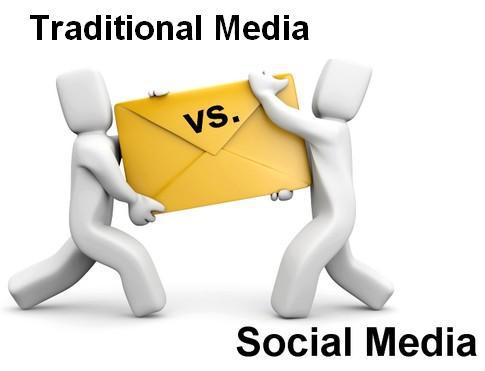
The question is a contention one within the business domain: Should fledging entrepreneurs and companies persist with traditional marketing or should they give more preference to new-age social media marketing? There is no easy answer as each entity or organization is different possessing discrete properties and operating under separate economic, technological, and social conditions.
Still, it is worthwhile to compare the two marketing approaches using certain parameters to help beginners determine the ideal technique to adopt:
1. Essential Suitability
Traditional marketing is the tried and tested marketing technique relying on established selling methods like conversations, live presentations, television advertisements, newspaper commercials, brochures, and even email. Beginners who do not have an intensive online campaign or are in the process of developing one would do well to stick to traditional marketing initially. Meanwhile, beginners who are already well-versed with social media marketing ought to include traditional marketing to broaden their selling efforts.
Social media marketing is a modern marketing phenomenon characterized by the extensive use of online resources such as Twitter, Facebook, Google Plus, LinkedIn, and other social networking portals. As hinted at earlier, this technique suits fledging enterprises that are social media savvy and conduct a robust online marketing operation.
2. Budget Involved
Entities that have just commenced operations usually have limited monetary resources or are under a tight budget.
Traditional marketing is a dearer proposition as opposed to social media marketing; costs incurred on television, print media, billboard, and radio advertising can collectively run into several hundred dollars. Therefore traditional marketing should only be adopted if beginners are well funded or have auxiliary financing options.
Social media marketing entails a lower day-to-day cost because a majority of social media portals do not charge usage fees although admittedly a lot of time is expended on the job. Thus this is the preferred means of selling for beginners. Moreover, the money saved can be utilized for other pressing organizational needs.
3. Interaction Closeness
Arguably, nascent enterprises need to interact with potential customers on a more intimate basis to earn goodwill and an instant rapport. Traditional marketing serves the purpose admirably in this regard as personal and face-to-face interactions like events, conferences, and meetings can lure customers in a better manner towards beginners' products and services.
Social media marketing does not enjoy the same intimate connection as both the seller and the buyer function in an online domain with their physical identities hidden from each other. Yet, beginners using social media marketing are advised to employ effective audio-visual aids to supplement their selling efforts and offset the adverse effects of non-personal marketing.
Some analysts, however, point out that social media marketing generates more community spirit and collective thinking and thus is superior to traditional marketing on a different intimacy plane.
4. Customer Profile
Beginners ought to conduct a thorough evaluation of their customers to discern their profiles and predominant preferences. Not only will this exercise elicit valuable insights but it will also determine which marketing technique to adopt.
If the customer profile is indeterminate or varied, beginners should employ traditional marketing as this technique reaches out to all sections of society regardless of age, gender, and economic status. On the other hand, if research reveals that most customers are young, erudite, and active users of the internet then social media marketing should be adopted.
5. External Factors
Existing environmental, governmental, and social conditions play a big role in deciding which method to adopt.
If new companies are given a free rein to conduct all their operations smoothly then beginners are free to adopt the marketing method they deem expedient. If however, for instance, the government imposes curbs on the usage of the internet or places restrictions on television advertising then beginners would need to alter their marketing strategies accordingly.
Whatever the choice, remember that the ultimate purpose is to attract potential buyers and draw attention to the beginners' products and services.
This is a guest post by Dazzle Rogers of workwelltogether.com, a site that offers savings and current information on comcast cable and internet, as well as other comcast bundled services.
Did you like this article? Please let me know by leaving me your valued comments.
Related articles:
5 Tips On Reaching Out To More Social Media Users
How To Expose Your Business With Social Media
Social Media Marketing: Are You Effective Or Obnoxious?
Engaging Consumers Through Social Media
Social Media Day Meet-ups: How Can They Work For You
5 Do's And 5 Don'ts In Social Media
Building Your Business With Social Media
The 10 Basic Rules Of Social Media Marketing
Top 14 Benefits Of Social Media Marketing
How To Use Facebook For Your Small Business
9 Tips For More Effective Facebook Marketing
If you found this or any of my other posts helpful, don't forget to +1 or share the posts to your favourite networks using the toolbar below or by using the "+1" and "Share" buttons located at the bottom of each post.
As ever, if you want to stay up to date with the latest blog posts, don't forget to follow via Google Friend Connect (button on sidebar), on NetworkedBlogs, via Email (maximum of one email per day), on Facebook and Google+ or by subscribing to our blog feed at:
http://feeds.feedburner.com/DereksHomeAndBusinessBlog
You can also follow me on Twitter @djones1509, Google+ and on Facebook at:
http://www.facebook.com/djones1509
https://plus.google.com/104849975941505117776
Until my next post on Friday, enjoy the rest of the week!
© 2013. This article is DMCA protected. Republication is prohibited.
Still, it is worthwhile to compare the two marketing approaches using certain parameters to help beginners determine the ideal technique to adopt:
1. Essential Suitability
Traditional marketing is the tried and tested marketing technique relying on established selling methods like conversations, live presentations, television advertisements, newspaper commercials, brochures, and even email. Beginners who do not have an intensive online campaign or are in the process of developing one would do well to stick to traditional marketing initially. Meanwhile, beginners who are already well-versed with social media marketing ought to include traditional marketing to broaden their selling efforts.
Social media marketing is a modern marketing phenomenon characterized by the extensive use of online resources such as Twitter, Facebook, Google Plus, LinkedIn, and other social networking portals. As hinted at earlier, this technique suits fledging enterprises that are social media savvy and conduct a robust online marketing operation.
2. Budget Involved
Entities that have just commenced operations usually have limited monetary resources or are under a tight budget.
Traditional marketing is a dearer proposition as opposed to social media marketing; costs incurred on television, print media, billboard, and radio advertising can collectively run into several hundred dollars. Therefore traditional marketing should only be adopted if beginners are well funded or have auxiliary financing options.
Social media marketing entails a lower day-to-day cost because a majority of social media portals do not charge usage fees although admittedly a lot of time is expended on the job. Thus this is the preferred means of selling for beginners. Moreover, the money saved can be utilized for other pressing organizational needs.
3. Interaction Closeness
Arguably, nascent enterprises need to interact with potential customers on a more intimate basis to earn goodwill and an instant rapport. Traditional marketing serves the purpose admirably in this regard as personal and face-to-face interactions like events, conferences, and meetings can lure customers in a better manner towards beginners' products and services.
Social media marketing does not enjoy the same intimate connection as both the seller and the buyer function in an online domain with their physical identities hidden from each other. Yet, beginners using social media marketing are advised to employ effective audio-visual aids to supplement their selling efforts and offset the adverse effects of non-personal marketing.
Some analysts, however, point out that social media marketing generates more community spirit and collective thinking and thus is superior to traditional marketing on a different intimacy plane.
4. Customer Profile
Beginners ought to conduct a thorough evaluation of their customers to discern their profiles and predominant preferences. Not only will this exercise elicit valuable insights but it will also determine which marketing technique to adopt.
If the customer profile is indeterminate or varied, beginners should employ traditional marketing as this technique reaches out to all sections of society regardless of age, gender, and economic status. On the other hand, if research reveals that most customers are young, erudite, and active users of the internet then social media marketing should be adopted.
5. External Factors
Existing environmental, governmental, and social conditions play a big role in deciding which method to adopt.
If new companies are given a free rein to conduct all their operations smoothly then beginners are free to adopt the marketing method they deem expedient. If however, for instance, the government imposes curbs on the usage of the internet or places restrictions on television advertising then beginners would need to alter their marketing strategies accordingly.
Whatever the choice, remember that the ultimate purpose is to attract potential buyers and draw attention to the beginners' products and services.
This is a guest post by Dazzle Rogers of workwelltogether.com, a site that offers savings and current information on comcast cable and internet, as well as other comcast bundled services.
Did you like this article? Please let me know by leaving me your valued comments.
Related articles:
5 Tips On Reaching Out To More Social Media Users
How To Expose Your Business With Social Media
Social Media Marketing: Are You Effective Or Obnoxious?
Engaging Consumers Through Social Media
Social Media Day Meet-ups: How Can They Work For You
5 Do's And 5 Don'ts In Social Media
Building Your Business With Social Media
The 10 Basic Rules Of Social Media Marketing
Top 14 Benefits Of Social Media Marketing
How To Use Facebook For Your Small Business
9 Tips For More Effective Facebook Marketing
If you found this or any of my other posts helpful, don't forget to +1 or share the posts to your favourite networks using the toolbar below or by using the "+1" and "Share" buttons located at the bottom of each post.
As ever, if you want to stay up to date with the latest blog posts, don't forget to follow via Google Friend Connect (button on sidebar), on NetworkedBlogs, via Email (maximum of one email per day), on Facebook and Google+ or by subscribing to our blog feed at:
http://feeds.feedburner.com/DereksHomeAndBusinessBlog
You can also follow me on Twitter @djones1509, Google+ and on Facebook at:
http://www.facebook.com/djones1509
https://plus.google.com/104849975941505117776
Until my next post on Friday, enjoy the rest of the week!
© 2013. This article is DMCA protected. Republication is prohibited.















